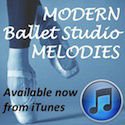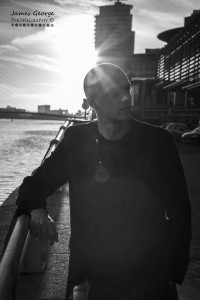
We love talking with musicians that are involved with ballet–after all–the music is such a big part of it! Today we have Christopher Hobson with us to talk about his experience playing for dancers and making music for class…
How did you get involved in doing music for ballet class?
I originally started playing for contemporary dance. I suppose like most musicians, I got into this by accident! I was playing a jazz gig and got talking to somebody at the bar who said they liked what I was playing and would I be interested in auditioning for a job playing for contemporary dance. As I wasn’t working at the time I thought ‘why not’! When I started I didn’t know what the job entailed and was thrown in at the deep end.
After a couple of years of contemporary dance I moved cities and took a job with Elmhurst School for Dance, specialising in ballet! This was the first time I’d ever played for ballet and again it was a real learning experience and some of the great teachers who were in this institution at the time took me under their wing and took the time to explain to me just what was required when playing for ballet and what the differences were in terms of style, accompaniment and support between ballet and contemporary dance. Without this support from colleagues I doubt I would be where I am today. I was only 18 when I first entered a dance studio as a musician!
What is the most difficult thing about creating music for dance class?
You have to be able to be creative, 100% of the time! There is no time to sit on your reputation or relax – I believe that my job is to inspire the dancers who are in the class and if I do my job well it will enable the dancers to not only do their job well, but enjoy doing their job. This can be particularly difficult if you’ve been stuck in a recording studio for days, travelling from venue theatre to theatre or just if you’re slightly tired!
What is the most rewarding thing about making music for ballet class?
When playing live, I try to use music from as many different genres as possible – from baroque, classical, jazz standards, musical theatre and popular culture – also not forgetting the occasional improvisations! I love it when a particular melody I play reflects the movement of a dancer. From behind the piano you can see the smiles on dancers faces and that of the ballet master. This makes me feel like the movement and music are working as one – just as it does in a good performance.
Do you find your approach has changed at all over time?
 Until I found my own ‘style’ and approach to class I continued to ‘play it safe’ and just use styles of repertoire and performance used by colleagues. Not only did I ‘copy’ but I also used to get incredibly nervous when playing for a new company or a new teacher. Now that I’ve become more confident in my abilities as an accompanist I continue to practice hugely but learnt to control my nerves and to ‘go with the flow’. I no longer approach any class with pre-conceived ideas that a plié should for example be danced on a 3/4!
Until I found my own ‘style’ and approach to class I continued to ‘play it safe’ and just use styles of repertoire and performance used by colleagues. Not only did I ‘copy’ but I also used to get incredibly nervous when playing for a new company or a new teacher. Now that I’ve become more confident in my abilities as an accompanist I continue to practice hugely but learnt to control my nerves and to ‘go with the flow’. I no longer approach any class with pre-conceived ideas that a plié should for example be danced on a 3/4!
What is coming up next for you?
I have just finished composing the ballet syllabus for the International Dance Teachers Association, writing a full length contemporary work for my students and also recording my own music (not specifically for dance!) and tackling orchestrations for a series of summer proms concerts! I believe that it is important for me as a musician to have as many different musical strings to my bow as possible – I love the variety that being a self employed musician gives me! Before I know it it will be Christmas time again and time for the release of Modern Ballet Studio Melodies, Volume 5!!
Interested in hearing Christopher’s music? It’s available on iTunes.
 BIO: Christopher started piano lessons at the age of 4. Aged 8 to 11, he attended the Royal Northern College of Music Junior School, under the tuition of Valerie Eastham. Later Christopher trained at the world famousChetham’s School of Music, studying classical piano with Peter Lawson and jazz piano with Les Chisnall.
BIO: Christopher started piano lessons at the age of 4. Aged 8 to 11, he attended the Royal Northern College of Music Junior School, under the tuition of Valerie Eastham. Later Christopher trained at the world famousChetham’s School of Music, studying classical piano with Peter Lawson and jazz piano with Les Chisnall.
Since leaving education, Christopher has worked in the dance field, gaining a wealth of experience playing at some of the most respected dance establishments in the UK such as Northern School of Contemporary Dance, Elmhurst School for Dance, Liverpool Institute for Performing Artsand Central School of Ballet, to name but a few. Whilst working at Northern Ballet (UK), Christopher had the privilege to work with many world renowned choreographers and directors (including Gillian Lynne, Mark Godden, David Nixon) on many productions including Lynne’s ‘A Simple Man’, Gable’s ‘Romeo and Juliet’ and ‘A Christmas Carol’, Nixon’s ‘Nutcracker’, ‘Hamlet’, ‘Swan Lake’, ‘Midsummer Night’s Dream’, ‘Peter Pan’ and also working closely on the revival of Claude-Michel Schönberg’s (Les Miserables, Miss Saigon) first ballet commission, ‘Wuthering Heights’.
Christopher’s musical tastes are very varied from early baroque, classical and romantic through to modern jazz, musical theatre and popular. This wide and varied musical interest along with his understanding of music and dance forms has led him being in high demand as an arranger. His first work for ballet appeared as Sadler’s Wells (London) in 2009, a jazz ballet entitled “As Time Goes By” with choreography by David Nixon and sung by jazz singing sensation, Peter Grant.
Christopher also has a keen interest in music for dance education. He often works with establishments & companies, accompanying classes in both Ballet and Contemporary disciplines.
Disclosure: Christopher Hobson has advertised on 4dancers




